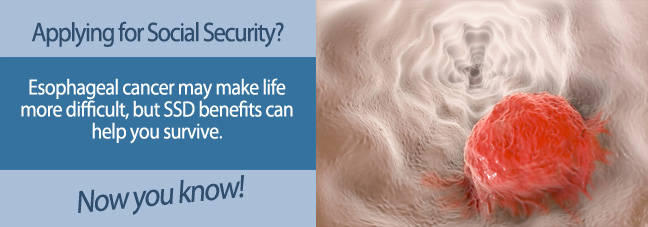The Social Security Administration (SSA) pays disability benefits to people who can’t maintain gainful employment because they have a physical or mental impairment that is expected to prevent them from working at least a year or end in death.
One of these conditions, which has both symptoms and a treatment regimen that can leave you unable to work, is esophageal cancer.
Esophageal Cancer Explained
As its name suggests, esophageal cancer originates in the esophagus. There are two distinct kinds of esophageal cancer, either of which can be severely disabling:
- Squamous cell carcinoma: originates in the flat cells lining the esophagus
- Adenocarcinoma: affects the mucus-producing cells along the cervical canal
Both types are prone to spreading to other parts of the body and producing debilitating symptoms such as:
- Difficulty swallowing
- Choking when eating
- Hoarse coughing
- Pressure or pain in the chest
- Fatigue and weight loss
Because esophageal cancer is typically discovered in its later stages, the prognosis for most patients is poor. This is why it is one of the SSA Compassionate Allowance conditions, which means it will get your disability application reviewed and (ideally) approved more quickly.

Qualifying for Disability Benefits
To be approved for one of the SSA disability benefits programs, the SSA will verify that your disability meets a listing in the Blue Book, which is its catalog of recognized impairments. Esophageal cancer appears in Section 13.16 Esophagus or stomach, which states that you will be considered disabled if the cancer:
- Is inoperable and unresectable
- Has extended to surrounding structures
- Is recurrent despite treatment OR
- Is of the small-cell (oat cell) variety
Having esophageal cancer will help you qualify for a Compassionate Allowance, which means that your application will be reviewed more quickly and you will receive a decision—as well as benefits—in as little as 20 days. This is welcome news when you are unable to work and in serious financial need.
The Application Process
After downloading a copy of the disability benefits application package or picking up a copy at your local SSA office, you must fill it out and return it to the SSA along with medical records that confirm your diagnosis, such as:
- Results of physical examinations
- Image scans such as X-rays, CT scans, and PET scans
- Biopsy results
- Esophagoscopy and/ or bronchoscopy results
- Treatment history as well as your response to each treatment
Every year the SSA receives literally millions of disability claims, with approximately 70% of them ultimately being rejected. If this happens to you, you have the option of appealing the decision, but the appeal process can be complicated. It’s a situation where proper representation can make a real difference.
Statistics suggest that when you submit your application or embark on the appeal process with assistance from a Social Security disability attorney or advocate, you are more likely to be approved than if you go it alone.
Representation is surprisingly affordable, and if it means a quicker approval of your claim, working with professionals can be well worth the cost of their services.